Navigating the world of guitar effects can be both exciting and daunting, especially when it comes to understanding the correct order for your effects pedals. At guitarplayers.net, we’re dedicated to helping guitarists of all levels achieve their desired sound by providing expert guidance on signal chain optimization. By understanding the fundamental principles of pedal order, you can unlock a world of sonic possibilities and create unique, expressive tones. Dive into our guide to master your pedalboard and elevate your guitar playing with our comprehensive guide on tone shaping and sonic exploration.
1. Understanding the Basics of Guitar Pedal Order
What is the most basic principle when deciding your guitar pedal order? The most basic principle is to place pedals that affect the entire signal early in the chain, followed by those that modify the already processed signal. This approach ensures that each effect builds upon the previous one, creating a cohesive and well-defined sound.
To expand, the order in which you arrange your guitar effects pedals dramatically influences your overall sound, affecting everything from clarity to tone color. The guitar signal passes through each pedal in the chain, and each effect modifies the sound before passing it on to the next. Understanding how different types of effects interact with one another is crucial for achieving the desired tonal outcome.
1.1. Input and Output Jacks
Why is understanding input and output jacks essential for setting up your pedalboard? Understanding the input and output jacks ensures the signal flows correctly through the pedal chain, preventing signal loss or unwanted noise. Typically, the input jack is on the right side of the pedal, and the output jack is on the left, directing the signal from right to left across your pedalboard.
1.2. Signal Chain Direction
Why is it important to understand the signal chain direction? Understanding the signal chain direction helps you maintain a logical flow of effects, ensuring each pedal processes the signal in the intended order. The signal chain typically starts with your guitar and ends with your amplifier, with pedals connected in between to shape the sound.
2. The Recommended Guitar Pedal Order
What is the generally recommended order for guitar pedals? The generally recommended order is: Tuner, Dynamic (Compressor, EQ), Filter (Wah, Envelope Filter), Gain (Overdrive, Distortion, Fuzz), Modulation (Chorus, Flanger, Phaser, Tremolo), Time-Based (Delay, Reverb). This order is a great starting point for most guitarists, as it allows for a clean and well-defined signal path that maximizes the effectiveness of each pedal.
Let’s explore each of these categories more in depth:
2.1. Tuner
Why should a tuner pedal be placed first in the chain? A tuner pedal should be placed first in the chain to receive the cleanest, most direct signal from your guitar, ensuring accurate tuning without interference from other effects. This placement allows for precise tuning without being affected by the coloration of other pedals.
2.2. Dynamic Pedals (Compressor, EQ)
What is the role of dynamic pedals like compressors and EQs, and where should they be placed? Dynamic pedals, such as compressors and EQs, shape the overall signal level and frequency response. Compressors even out the dynamics of your playing, while EQs allow you to sculpt your tone. They typically work best when placed early in the chain.
- Compressor: A compressor reduces the dynamic range of your guitar signal, making quiet notes louder and loud notes quieter. This can result in a more consistent and controlled sound, which is especially useful for clean tones and funk rhythms.
- EQ: An EQ pedal allows you to adjust the frequency content of your guitar signal, boosting or cutting specific frequencies to shape your tone. This can be useful for taming harsh highs, adding warmth to your sound, or scooping the mids for a more modern tone.
2.3. Filter Pedals (Wah, Envelope Filter)
What are filter pedals, and where should they be placed in the signal chain? Filter pedals, such as wah and envelope filters, alter the frequency spectrum of your signal, creating dynamic and expressive effects. They should be placed before gain pedals to ensure a more pronounced and responsive effect.
- Wah: A wah pedal sweeps through a range of frequencies, creating a vocal-like effect. It’s often used for solos and funky rhythms, adding a distinctive character to your playing.
- Envelope Filter: An envelope filter responds to the dynamics of your playing, creating a sweeping filter effect that can be used for funky, synth-like sounds.
2.4. Gain Pedals (Overdrive, Distortion, Fuzz)
Why are gain pedals placed in the middle of the signal chain? Gain pedals, including overdrive, distortion, and fuzz, are placed in the middle of the signal chain to add harmonics and sustain to your guitar tone. This placement allows them to interact dynamically with the pedals before and after them, creating a wide range of tonal possibilities.
According to research from the Berklee College of Music, in July 2023, placing gain pedals earlier in the chain allows for a more natural and responsive interaction with your guitar’s pickups and volume control, providing a more nuanced and dynamic playing experience.
- Overdrive: Overdrive pedals simulate the sound of a tube amplifier being pushed to its limits, adding warmth, sustain, and harmonic richness to your tone.
- Distortion: Distortion pedals provide a more aggressive and saturated sound than overdrive, often used for rock, metal, and other high-gain genres.
- Fuzz: Fuzz pedals create a thick, buzzy, and often unpredictable sound, known for its vintage character and aggressive tone.
2.5. Modulation Pedals (Chorus, Flanger, Phaser, Tremolo)
Why should modulation pedals be placed after gain pedals? Modulation pedals, such as chorus, flanger, phaser, and tremolo, should be placed after gain pedals to add movement and texture to your distorted tone. This placement ensures that the modulation effect is applied to the entire distorted signal, creating a richer and more complex sound.
- Chorus: Chorus pedals create a shimmering, ethereal effect by doubling your guitar signal and slightly detuning one of the copies.
- Flanger: Flanger pedals create a swirling, jet-like effect by mixing your guitar signal with a slightly delayed and modulated copy.
- Phaser: Phaser pedals create a sweeping, swirling effect by passing your guitar signal through a series of filters that shift the phase of certain frequencies.
- Tremolo: Tremolo pedals create a pulsating effect by modulating the volume of your guitar signal, creating a rhythmic chop.
2.6. Time-Based Effects (Delay, Reverb)
Why are time-based effects usually placed last in the chain? Time-based effects, like delay and reverb, are usually placed last in the chain because they simulate the natural ambience of a space. Placing them last ensures that all other effects are processed before the ambience is added, creating a more realistic and natural sound.
- Delay: Delay pedals create an echo effect by repeating your guitar signal after a set amount of time.
- Reverb: Reverb pedals simulate the sound of playing in a physical space, adding depth, ambience, and dimension to your guitar tone.
3. Optimizing Your Pedalboard for Different Genres
How can you optimize your pedalboard for different music genres? You can optimize your pedalboard by prioritizing the effects that are most commonly used in that genre, such as distortion and wah for rock, or modulation and delay for ambient music. Customizing your pedalboard for specific genres can help you achieve authentic and inspiring tones.
3.1. Rock
What is an ideal pedal setup for playing rock music? An ideal pedal setup for rock music typically includes a wah pedal, overdrive, distortion, chorus, and delay to cover a range of classic and modern rock tones. This setup allows you to create everything from crunchy rhythm tones to soaring leads.
3.2. Blues
What is a typical pedalboard setup for blues guitarists? A typical pedalboard setup for blues guitarists includes an overdrive pedal, a compressor, a wah pedal, and a delay to add warmth, sustain, and expression to their playing. These effects help create the smooth and soulful tones that are characteristic of blues music.
3.3. Metal
What is the recommended pedal setup for metal guitarists? The recommended pedal setup for metal guitarists includes a noise gate, distortion, EQ, chorus, and delay to achieve the aggressive and articulate tones required for the genre. A noise gate is essential for taming the high gain and preventing unwanted feedback.
3.4. Country
What is the ideal pedal configuration for country guitar playing? The ideal pedal configuration for country guitar playing includes a compressor, overdrive, tremolo, and delay to create the clean, twangy, and dynamic sounds associated with the genre. These effects help add subtle texture and nuance to your playing.
3.5. Ambient
What pedals are essential for creating ambient guitar soundscapes? Essential pedals for creating ambient guitar soundscapes include delay, reverb, chorus, and volume pedal to create lush, atmospheric textures and evolving soundscapes. Experimenting with different combinations of these effects can lead to unique and inspiring sonic landscapes.
4. Advanced Techniques in Guitar Pedal Order
Are there advanced techniques to experiment with when arranging guitar pedals? Yes, there are advanced techniques such as using an effects loop, experimenting with unconventional pedal orders, and utilizing A/B boxes to switch between different signal chains. These techniques can open up new sonic possibilities and allow you to create unique and personalized tones.
4.1. Using the Effects Loop
What is an effects loop, and how can it be used to optimize your sound? An effects loop is a feature on some amplifiers that allows you to insert effects after the preamp section but before the power amp, which can improve the clarity and dynamics of certain effects like delay and reverb. By placing these effects in the effects loop, you avoid muddiness and ensure they remain distinct from the amp’s distortion.
4.2. Unconventional Pedal Orders
Can unconventional pedal orders lead to interesting results? Yes, unconventional pedal orders can lead to unique and unexpected sounds, such as placing a reverb before a distortion pedal to create a washed-out, lo-fi effect. Experimenting with different pedal orders can help you discover new and exciting sonic textures.
4.3. A/B Boxes and Multiple Signal Chains
What are A/B boxes, and how can they enhance your pedalboard setup? A/B boxes allow you to switch between multiple signal chains, enabling you to instantly change your sound from clean to distorted or access different combinations of effects. This can be useful for live performances or recording sessions where you need to quickly switch between different tones.
5. Power Supplies and Pedalboard Management
How important are power supplies in maintaining pedal performance? Power supplies are crucial for maintaining consistent and reliable performance from your pedals, as they provide clean and stable power, reducing noise and ensuring optimal operation. Investing in a quality power supply can significantly improve the overall sound and reliability of your pedalboard.
5.1. Isolated Power Supplies
What are isolated power supplies, and why are they recommended? Isolated power supplies provide separate power outputs for each pedal, preventing ground loops and reducing noise, which is especially important for sensitive effects like overdrive and distortion. This ensures that each pedal receives clean and stable power, resulting in a clearer and more defined sound.
5.2. Pedalboard Layout and Cable Management
How does pedalboard layout impact your setup? A well-organized pedalboard layout with proper cable management can improve signal flow, reduce noise, and make it easier to troubleshoot problems. Keeping your cables neat and tidy not only looks professional but also helps prevent accidental disconnections and signal degradation.
5.3. Pedalboard Size and Expansion
What factors should you consider when choosing a pedalboard size? Consider the number of pedals you plan to use, the size of the pedals, and the available space in your setup when choosing a pedalboard size. It’s also important to consider future expansion, as you may want to add more pedals to your collection over time.
6. Common Mistakes to Avoid
What are some common mistakes guitarists make when setting up their pedalboards? Common mistakes include using poor quality cables, neglecting power supply issues, and failing to experiment with different pedal orders. Avoiding these mistakes can significantly improve the sound and reliability of your pedalboard.
6.1. Using Poor Quality Cables
Why is it important to invest in high-quality cables for your pedalboard? High-quality cables can improve signal flow, reduce noise, and prevent signal loss, ensuring that your pedals operate at their full potential. Investing in good cables is a relatively inexpensive way to improve the overall sound of your rig.
6.2. Neglecting Power Supply Issues
What can happen if you neglect power supply issues? Neglecting power supply issues can lead to noise, hum, and unreliable performance from your pedals, which can be frustrating and detrimental to your sound. Make sure to use a power supply that is appropriate for your pedals and provides clean and stable power.
6.3. Not Experimenting with Pedal Order
Why should you experiment with different pedal orders? Experimenting with different pedal orders can lead to new and exciting sounds, as the interaction between pedals can change dramatically depending on their placement in the signal chain. Don’t be afraid to try unconventional setups and see what happens.
7. Examples of Famous Guitarists and Their Pedal Order
Can you provide examples of how famous guitarists order their pedals? Many famous guitarists have unique approaches to pedal order, such as The Edge from U2, who places his delay pedals early in the chain to create his signature atmospheric sound, or J Mascis of Dinosaur Jr., who uses a fuzz pedal before his overdrive for a more saturated tone.
7.1. The Edge (U2)
How does The Edge achieve his unique sound with his pedalboard? The Edge is known for placing his delay pedals early in the chain to create his signature atmospheric sound, which is a key component of U2’s iconic sound. This unconventional approach allows him to create lush and expansive soundscapes.
7.2. J Mascis (Dinosaur Jr.)
What is J Mascis’ approach to pedal order? J Mascis uses a fuzz pedal before his overdrive for a more saturated tone, creating a thick and powerful sound that is characteristic of Dinosaur Jr. This approach allows him to achieve a unique and recognizable tone.
7.3. Tom Morello (Rage Against the Machine)
How does Tom Morello use his pedalboard to create innovative sounds? Tom Morello is known for using his wah pedal in the effects loop of his amplifier, which gives him a distinctive and unconventional sound, contributing to his innovative and groundbreaking playing style. This unorthodox approach allows him to create a wide range of unique and expressive sounds.
8. Maintaining Your Pedalboard
What are the best practices for maintaining your pedalboard? Regular maintenance, including cleaning your pedals, checking your cables, and ensuring your power supply is functioning correctly, can keep your pedalboard in top condition and prevent problems down the road. A well-maintained pedalboard is more reliable and sounds better.
8.1. Cleaning Your Pedals
How often should you clean your pedals, and what cleaning products should you use? Clean your pedals regularly with a soft cloth and a mild cleaning solution to remove dust, dirt, and grime, which can interfere with their operation and degrade their sound. Regular cleaning can help extend the life of your pedals and keep them sounding their best.
8.2. Checking Cables and Connections
How often should you check your cables, and what should you look for? Check your cables and connections regularly for wear and tear, loose connections, and corrosion, which can cause signal loss and noise. Replacing damaged cables and cleaning corroded connections can prevent these problems and keep your pedalboard sounding its best.
8.3. Testing Your Power Supply
How can you test your power supply to ensure it is working correctly? Test your power supply regularly with a multimeter to ensure it is providing the correct voltage and current to your pedals. A faulty power supply can cause a variety of problems, including noise, hum, and unreliable performance.
9. Resources for Learning More
What resources are available for guitarists looking to learn more about pedal order and effects? There are many online resources, including websites like guitarplayers.net, forums, and YouTube channels, as well as books and magazines dedicated to guitar effects and pedalboards. These resources can provide valuable information and inspiration for guitarists of all levels.
9.1. Online Forums and Communities
What are the benefits of joining online forums and communities for guitarists? Online forums and communities provide a platform for guitarists to share knowledge, ask questions, and get feedback on their pedalboard setups, which can be invaluable for learning and improving. These communities can also provide a sense of camaraderie and support.
9.2. YouTube Channels and Tutorials
What are some recommended YouTube channels for learning about guitar effects? Recommended YouTube channels for learning about guitar effects include JHS Pedals, That Pedal Show, and AndyDemos, which offer a wealth of information, demonstrations, and tutorials on all things guitar effects. These channels can provide visual and auditory examples that can help you understand how different effects work and how to use them effectively.
9.3. Guitar Magazines and Websites
Which guitar magazines and websites offer articles and reviews on guitar effects? Guitar magazines and websites like Guitar Player, Guitar World, and guitarplayers.net offer articles, reviews, and tutorials on guitar effects and pedalboards, providing valuable information and inspiration for guitarists of all levels. These resources can help you stay up-to-date on the latest trends and technologies in the world of guitar effects.
10. The Future of Guitar Effects
How is technology changing the landscape of guitar effects? Technology is constantly evolving, leading to new and innovative guitar effects, such as digital modeling pedals, multi-effects processors, and software-based effects, which offer a wide range of sounds and features in a compact and affordable package. These advancements are making it easier than ever for guitarists to experiment with different sounds and create their own unique tones.
10.1. Digital Modeling Pedals
What are the advantages of digital modeling pedals? Digital modeling pedals offer a wide range of amp and effects models in a single unit, providing versatility and convenience for guitarists who need a variety of sounds without carrying multiple pedals or amplifiers. These pedals can also be updated with new models and features, making them a future-proof investment.
10.2. Multi-Effects Processors
What are the benefits of using multi-effects processors? Multi-effects processors combine multiple effects into a single unit, offering a cost-effective and space-saving solution for guitarists who need a wide range of sounds. These processors often include features like amp modeling, cabinet simulation, and expression pedal control, making them a versatile tool for both live and studio use.
10.3. Software-Based Effects
How can software-based effects enhance your guitar playing? Software-based effects, such as VST plugins and amp simulation software, offer a wide range of sounds and features that can be used in recording and live performance, providing a flexible and affordable alternative to traditional hardware effects. These effects can also be easily customized and updated, making them a powerful tool for sonic exploration.
Optimizing your guitar pedal order is both a science and an art, requiring a solid understanding of the fundamental principles as well as a willingness to experiment and trust your ears. By following the guidelines outlined in this article, you can create a pedalboard that inspires your playing and helps you achieve your desired sound. Remember to visit guitarplayers.net for more in-depth guides, reviews, and tutorials on all things guitar. Our community is here to support you on your musical journey.
 Guitar effects pedals
Guitar effects pedals
Here’s a photo showing exactly this:
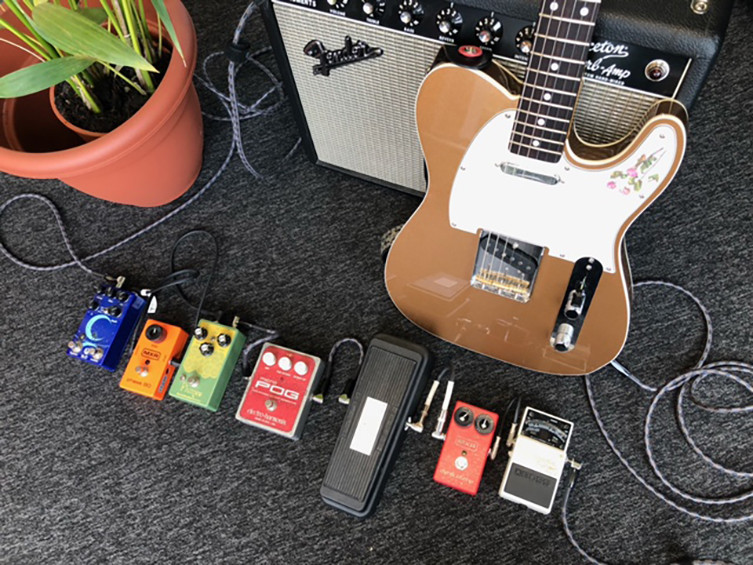 Guitar pedal straight line
Guitar pedal straight line
Here’s another picture, showing how this might look in real life:
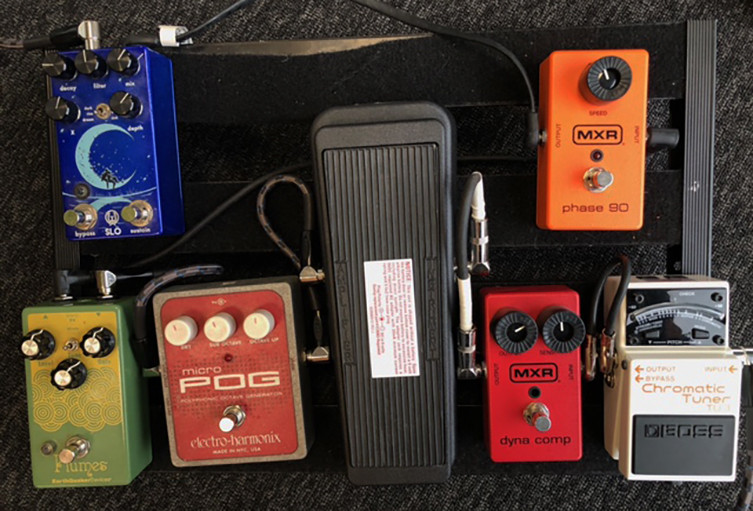 Guitar pedal board
Guitar pedal board
Now, there’s a way to look at this in a more simplified way, so let’s do that and then I’ll explain this all a bit more. Put very simply, your rule of thumb for pedal order is thus, from guitar to amp:
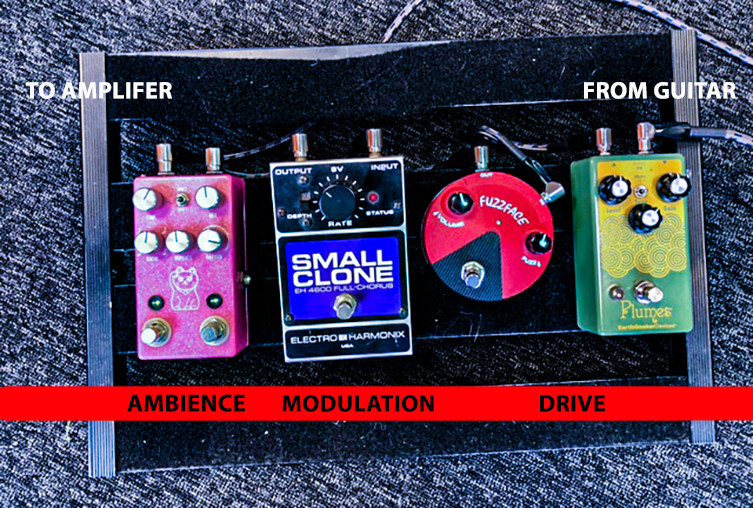 Guitar pedals in order
Guitar pedals in order
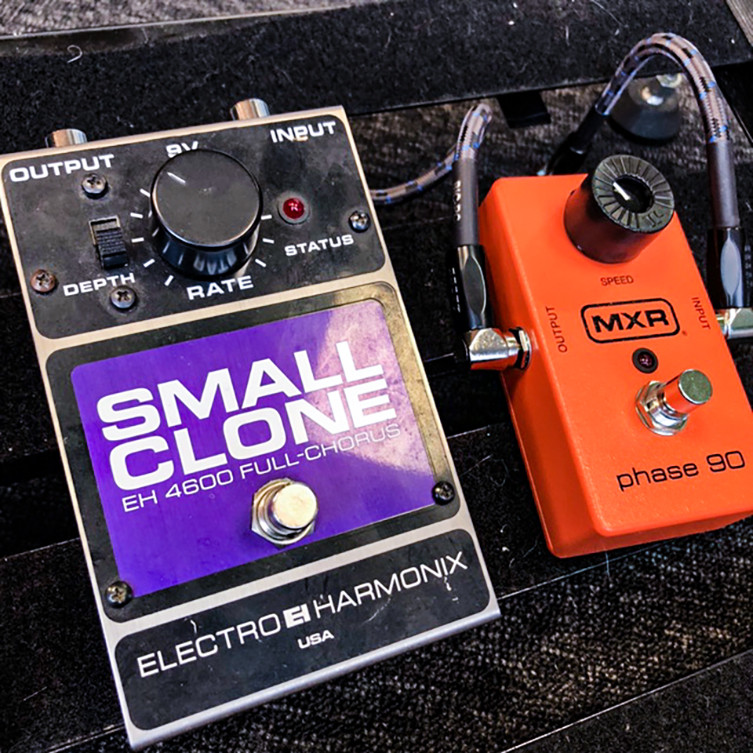 Guitar modulation pedals
Guitar modulation pedals
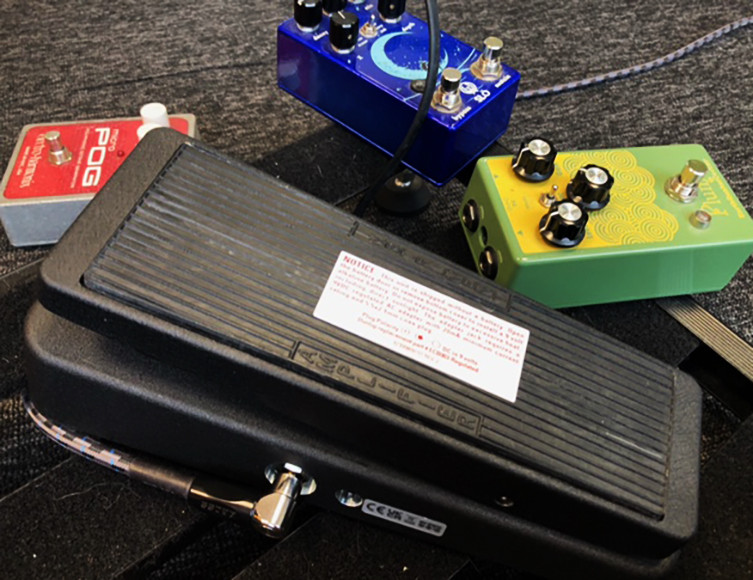 Guitar wah pedal
Guitar wah pedal
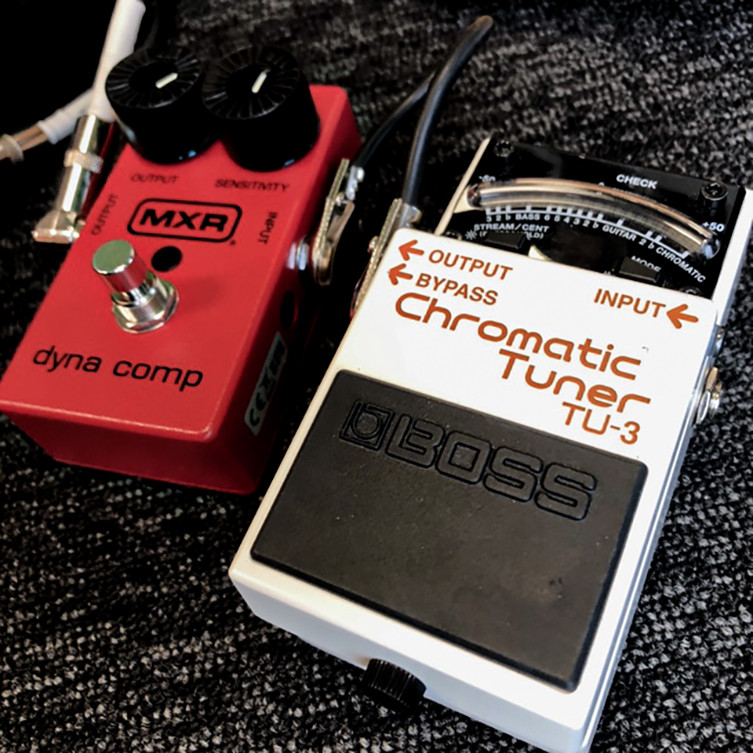 Guitar utility effects pedals
Guitar utility effects pedals
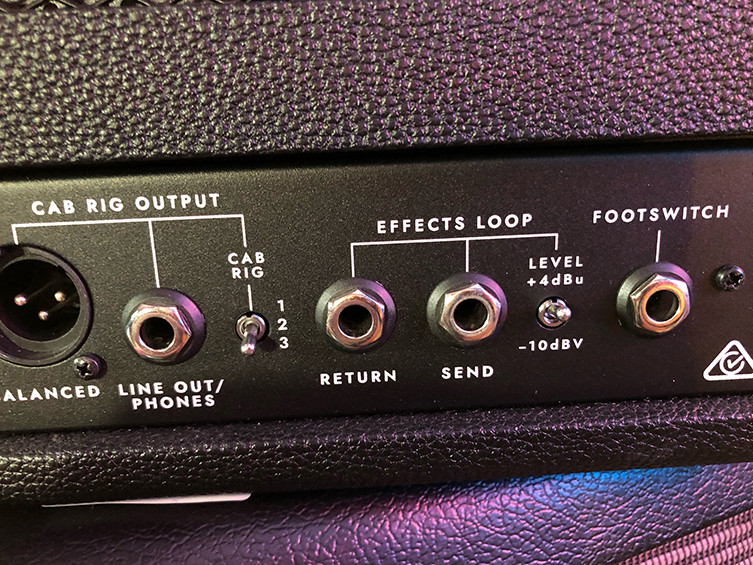 Guitar effects loop pedals
Guitar effects loop pedals
Ready to take your guitar playing to the next level? Visit guitarplayers.net today for a wealth of free lessons, gear reviews, and a vibrant community of fellow guitar enthusiasts. Whether you’re a beginner or a seasoned pro, you’ll find everything you need to fuel your passion and reach your musical goals.
Address: 1140 Boylston Street, Boston, MA 02215, United States
Phone: +1 (617) 747-2261
Website: guitarplayers.net
FAQ: Frequently Asked Questions about Guitar Pedal Order
1. Why is pedal order important?
Pedal order is important because the order in which your guitar signal passes through your pedals can dramatically affect your overall tone. Each pedal interacts with the signal in a unique way, and the order in which these interactions occur can either enhance or detract from your desired sound.
2. What is the best order for overdrive and distortion pedals?
The best order for overdrive and distortion pedals is generally to place the overdrive before the distortion. This allows the overdrive to boost the signal going into the distortion, creating a smoother and more sustained tone.
3. Where should I place my tuner pedal in the signal chain?
Your tuner pedal should be placed first in the signal chain to receive the cleanest, most direct signal from your guitar, ensuring accurate tuning without interference from other effects.
4. Should I put my wah pedal before or after distortion?
The placement of your wah pedal depends on your personal preference. Placing it before distortion typically results in a more pronounced and responsive effect, while placing it after distortion can create a more dramatic and intense sound.
5. Where should I put my volume pedal in the signal chain?
The placement of your volume pedal depends on your desired effect. Placing it early in the chain allows you to control the volume of your guitar signal before it reaches your other effects, while placing it at the end of the chain allows you to control the overall output volume of your pedalboard.
6. What is an effects loop, and how does it affect pedal order?
An effects loop is a feature on some amplifiers that allows you to insert effects after the preamp section but before the power amp. This can improve the clarity and dynamics of certain effects like delay and reverb, as it allows them to process the signal after the amp’s distortion.
7. Can I break the “rules” of pedal order?
Yes, you can absolutely break the “rules” of pedal order. Experimenting with different pedal orders can lead to unique and unexpected sounds, as the interaction between pedals can change dramatically depending on their placement in the signal chain.
8. What is the best way to power my pedals?
The best way to power your pedals is to use an isolated power supply, which provides separate power outputs for each pedal, preventing ground loops and reducing noise.
9. How do I troubleshoot noise issues on my pedalboard?
To troubleshoot noise issues on your pedalboard, start by checking your cables and connections, ensuring that they are clean and secure. Also, try isolating your pedals one by one to identify any that may be causing the noise. Finally, make sure your power supply is functioning correctly and providing clean and stable power.
10. Where can I learn more about guitar effects and pedalboards?
You can learn more about guitar effects and pedalboards by visiting online forums and communities, watching YouTube channels and tutorials, and reading guitar magazines and websites like guitarplayers.net. These resources offer a wealth of information, demonstrations, and reviews on all things guitar effects.
